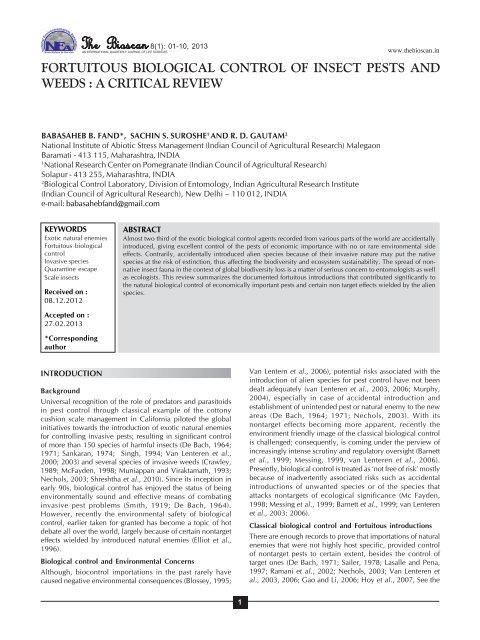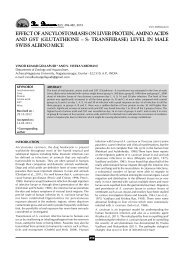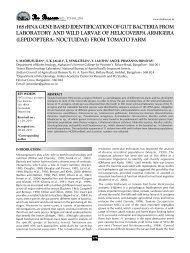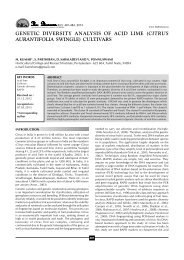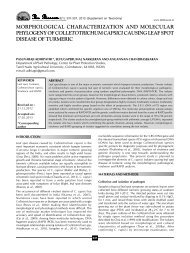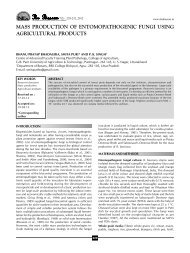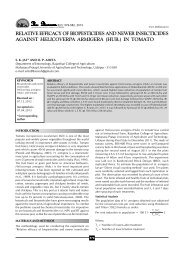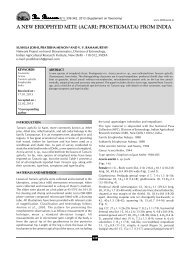Fortuitous biological control of insect pests and ... - THE BIOSCAN
Fortuitous biological control of insect pests and ... - THE BIOSCAN
Fortuitous biological control of insect pests and ... - THE BIOSCAN
- No tags were found...
You also want an ePaper? Increase the reach of your titles
YUMPU automatically turns print PDFs into web optimized ePapers that Google loves.
NSave Nature to Survive8(1): 01-10, 2013www.thebioscan.inFORTUITOUS BIOLOGICAL CONTROL OF INSECT PESTS ANDWEEDS : A CRITICAL REVIEWBABASAHEB B. FAND*, SACHIN S. SUROSHE 1 AND R. D. GAUTAM 2National Institute <strong>of</strong> Abiotic Stress Management (Indian Council <strong>of</strong> Agricultural Research) MalegaonBaramati - 413 115, Maharashtra, INDIA1National Research Center on Pomegranate (Indian Council <strong>of</strong> Agricultural Research)Solapur - 413 255, Maharashtra, INDIA2Biological Control Laboratory, Division <strong>of</strong> Entomology, Indian Agricultural Research Institute(Indian Council <strong>of</strong> Agricultural Research), New Delhi – 110 012, INDIAe-mail: babasahebf<strong>and</strong>@gmail.comKEYWORDSExotic natural enemies<strong>Fortuitous</strong> <strong>biological</strong><strong>control</strong>Invasive speciesQuarantine escapeScale <strong>insect</strong>sReceived on :08.12.2012ABSTRACTAlmost two third <strong>of</strong> the exotic <strong>biological</strong> <strong>control</strong> agents recorded from various parts <strong>of</strong> the world are accidentallyintroduced, giving excellent <strong>control</strong> <strong>of</strong> the <strong>pests</strong> <strong>of</strong> economic importance with no or rare environmental sideeffects. Contrarily, accidentally introduced alien species because <strong>of</strong> their invasive nature may put the nativespecies at the risk <strong>of</strong> extinction, thus affecting the biodiversity <strong>and</strong> ecosystem sustainability. The spread <strong>of</strong> nonnative<strong>insect</strong> fauna in the context <strong>of</strong> global biodiversity loss is a matter <strong>of</strong> serious concern to entomologists as wellas ecologists. This review summarizes the documented fortuitous introductions that contributed significantly tothe natural <strong>biological</strong> <strong>control</strong> <strong>of</strong> economically important <strong>pests</strong> <strong>and</strong> certain non target effects wielded by the alienspecies.Accepted on :27.02.2013*CorrespondingauthorINTRODUCTIONBackgroundUniversal recognition <strong>of</strong> the role <strong>of</strong> predators <strong>and</strong> parasitoidsin pest <strong>control</strong> through classical example <strong>of</strong> the cottonycushion scale management in California piloted the globalinitiatives towards the introduction <strong>of</strong> exotic natural enemiesfor <strong>control</strong>ling invasive <strong>pests</strong>; resulting in significant <strong>control</strong><strong>of</strong> more than 150 species <strong>of</strong> harmful <strong>insect</strong>s (De Bach, 1964;1971; Sankaran, 1974; Singh, 1994; Van Lenteren et al.,2000; 2003) <strong>and</strong> several species <strong>of</strong> invasive weeds (Crawley,1989; McFayden, 1998; Muniappan <strong>and</strong> Viraktamath, 1993;Nechols, 2003; Shreshtha et al., 2010). Since its inception inearly 90s, <strong>biological</strong> <strong>control</strong> has enjoyed the status <strong>of</strong> beingenvironmentally sound <strong>and</strong> effective means <strong>of</strong> combatinginvasive pest problems (Smith, 1919; De Bach, 1964).However, recently the environmental safety <strong>of</strong> <strong>biological</strong><strong>control</strong>, earlier taken for granted has become a topic <strong>of</strong> hotdebate all over the world, largely because <strong>of</strong> certain nontargeteffects wielded by introduced natural enemies (Elliot et al.,1996).Biological <strong>control</strong> <strong>and</strong> Environmental ConcernsAlthough, bio<strong>control</strong> importations in the past rarely havecaused negative environmental consequences (Blossey, 1995;Van Lentern et al., 2006), potential risks associated with theintroduction <strong>of</strong> alien species for pest <strong>control</strong> have not beendealt adequately (van Lenteren et al., 2003, 2006; Murphy,2004), especially in case <strong>of</strong> accidental introduction <strong>and</strong>establishment <strong>of</strong> unintended pest or natural enemy to the newareas (De Bach, 1964; 1971; Nechols, 2003). With itsnontarget effects becoming more apparent, recently theenvironment friendly image <strong>of</strong> the classical <strong>biological</strong> <strong>control</strong>is challenged; consequently, is coming under the perview <strong>of</strong>increasingly intense scrutiny <strong>and</strong> regulatory oversight (Barnettet al., 1999; Messing, 1999, van Lenteren et al., 2006).Presently, <strong>biological</strong> <strong>control</strong> is treated as ‘not free <strong>of</strong> risk’ mostlybecause <strong>of</strong> inadvertently associated risks such as accidentalintroductions <strong>of</strong> unwanted species or <strong>of</strong> the species thatattacks nontargets <strong>of</strong> ecological significance (Mc Fayden,1998; Messing et al., 1999; Barnett et al., 1999; van Lenterenet al., 2003; 2006).Classical <strong>biological</strong> <strong>control</strong> <strong>and</strong> <strong>Fortuitous</strong> introductionsThere are enough records to prove that importations <strong>of</strong> naturalenemies that were not highly host specific, provided <strong>control</strong><strong>of</strong> nontarget <strong>pests</strong> to certain extent, besides the <strong>control</strong> <strong>of</strong>target ones (De Bach, 1971; Sailer, 1978; Lasalle <strong>and</strong> Pena,1997; Ramani et al., 2002; Nechols, 2003; Van Lenteren etal., 2003, 2006; Gao <strong>and</strong> Li, 2006; Hoy et al., 2007, See the1
BABASAHEB B. FAND et al.,Table 1 for details).This phenomenon <strong>of</strong> recruitment <strong>of</strong>accidentally introduced exotic natural enemy on exotic ornative pest <strong>and</strong>/ or vice-a-versa has been described earlier as‘fortuitous <strong>biological</strong> <strong>control</strong>’ (De Bach, 1971). Thus, it can besaid that fortuitous <strong>biological</strong> <strong>control</strong> is the unintentionalreduction <strong>and</strong> maintenance <strong>of</strong> pest population by a naturalenemy wherein either the enemy or the pest is non-indigenous(DeBach, 1971; Nechols, 2003). It encompasses a part <strong>of</strong>naturally occurring <strong>biological</strong> <strong>control</strong>, however invariablyassociated with intentional <strong>and</strong> planned program <strong>of</strong> classical<strong>biological</strong> <strong>control</strong> (Ooi, 1987; Nechols, 2003).Globalization <strong>and</strong> liberalization <strong>of</strong> world agricultural tradecoupled with the rapid transport <strong>and</strong> communication meansnowadays, have substantially <strong>and</strong> plausibly increased thechances <strong>of</strong> accidental introductions <strong>of</strong> <strong>insect</strong>-<strong>pests</strong>, pathogens,weeds <strong>and</strong> other unwanted organisms to the new areas wherethey were not known to occur previously, along with theconsignments (Ooi, 1987; Mc Neely, 2001; Ramani, 2004a).To quote few <strong>of</strong> the examples are, serpentine leaf minorLiriomyza trifolii (Burgess) introduced from Florida to Californiaalong with cut chrysanthemum flowers (Parella et al., 1981),C<strong>of</strong>fee berry borer Hypothenemus hampei Ferrari entered intoIndia along with c<strong>of</strong>fee seeds from Sri Lanka (Kumar et al.,1990), Parthenium hysterophorous L. introduced from Mexicoas seed contaminant in food grains imported to India(Krishnamurthy et al., 1977). Similarly, several studies acrossthe globe revealed that, most <strong>of</strong> the cases <strong>of</strong> accidentalintroductions <strong>of</strong> unintended species <strong>of</strong> natural enemies werefound invariably associated with the purposeful importations<strong>of</strong> exotic natural enemies for classical <strong>biological</strong> <strong>control</strong>(DeBach, 1971; Ooi, 1987; van Lenteren et al., 2003; 2006).Apparently, the fortuitous <strong>biological</strong> <strong>control</strong> seems to bebeneficial as accidentally introduced natural enemies in pastdid quiet excellent job <strong>of</strong> <strong>control</strong>ling <strong>pests</strong> <strong>of</strong> economicimportance. However, the native species may be placed at therisk <strong>of</strong> extinction by accidentally introduced organisms throughcompetitive displacement <strong>and</strong> reduced abundance (Elliot etal., 1996; Obrycki et al., 1998), leading to <strong>biological</strong> invasions.The rapid <strong>and</strong> serious effects <strong>of</strong> species invasions <strong>and</strong>biodiversity loss instigated global discussions on the growingconcerns <strong>of</strong> environmental risks through exotic introductionsfor the <strong>biological</strong> <strong>control</strong>. As such, the earlier knownec<strong>of</strong>riendly version <strong>of</strong> the <strong>biological</strong> <strong>control</strong> has been putunder the custody <strong>of</strong> strict regulatory framework.In this review, we tried to enlighten the issues <strong>and</strong> ideas <strong>of</strong>relevance to the topic; the possible means for the fortuitous<strong>biological</strong> <strong>control</strong> to occur along with the important casehistories occurred in various groups <strong>of</strong> <strong>insect</strong> <strong>pests</strong> <strong>and</strong> weeds.The possible environmental impacts <strong>of</strong> fortuitous introductions<strong>of</strong> exotic species are also discussed.How fortuitous: accidental or intentional?According to the De Bach (1964; 1971) <strong>and</strong> Nichols (2003),fortuitous <strong>biological</strong> <strong>control</strong> can take place through either <strong>of</strong>the possible means such as quarantine escape, recruitment <strong>of</strong>indigenous natural enemy on exotic pets <strong>and</strong>/ or recruitment<strong>of</strong> the purposefully imported natural enemy on the nontargetindigenous pest. As stated earlier, most <strong>of</strong> the exotic naturalenemies found in various parts <strong>of</strong> the world have beenaccidentally introduced (De Bach, 1971; Sailer, 1978; Charles,1998). In general, large numbers <strong>of</strong> cases <strong>of</strong> fortuitousintroductions were found mostly in the parasitoids than thepredators <strong>and</strong> those associated with the Hemipteran <strong>pests</strong>than the other groups <strong>of</strong> <strong>insect</strong>s because <strong>of</strong> sessile <strong>and</strong> crypticnature <strong>of</strong> these <strong>pests</strong> <strong>and</strong> the parasitoids are likely to be carriedas immatures in parasitized or overwintering hosts (Sailer, 1978:Nechols, 2003).In this section, we discussed certain ecological, <strong>biological</strong><strong>and</strong> especially anthropogenic mechanisms involved infortuitous <strong>biological</strong> <strong>control</strong>, explained with relevant examples.We compiled through extensive literature review the importantexamples <strong>of</strong> fortuitous introductions that occurredinadvertently in various groups <strong>of</strong> <strong>insect</strong>-<strong>pests</strong> <strong>and</strong> weeds,invariably associated with either the purposeful importations<strong>of</strong> exotic bioagents or transboundary movements <strong>of</strong>agricultural produce.Quarantine Escape or accidental entry along with hostWith the galvanization <strong>of</strong> certain nontarget environmentaleffects, the classical <strong>biological</strong> <strong>control</strong> has now become asubject <strong>of</strong> legislative <strong>control</strong> (Messing et al., 1999; Barnett etal., 1999; van Lenteren et al., 2006). Currently, almost all thecountries in the world have in place, a well established system<strong>of</strong> quarantine legislation for regulating import <strong>and</strong> analysis <strong>of</strong>risks associated with exotic bio<strong>control</strong> agent introductions(IPPC, 1997; Shine et al., 2000; DAC, 2006; FAO, 2006).Despite the strict enforcement <strong>of</strong> quarantine, the accidentalintroductions <strong>of</strong> exotic <strong>insect</strong>-<strong>pests</strong> <strong>and</strong> their natural enemiesseems to be increasingly common due to intense <strong>and</strong> rapidcommercial exchanges through world agricultural trade;making the species invasions a serious issue <strong>of</strong> global concern(Murphy, 2004; Ramani, 2004). Increased transboundarymovement <strong>of</strong> agricultural produce with increased global trade<strong>and</strong> tourism has resulted in accidental introductions <strong>of</strong>invasive, alien species in many parts <strong>of</strong> the world; representingserious threat to native biodiversity (Ooi, 1987; McNeely, 2001;Murphy, 2004; Ramani, 2004b; Reddy et al., 2008).Unlike predators, the parasitoids being carried as immaturesin overwintering/ parasitized host stages are most likely toescape the quarantine <strong>and</strong> get accidentally entered into thenew areas (Nechols, 2003). In such cases, the introduced<strong>pests</strong> may be restricted from establishment <strong>and</strong> spread in newareas by accompanying natural enemies, because both thepest <strong>and</strong> the natural enemy being non-native; there is likelychance that the sympatric relationship in their original habitathelp introduced natural enemy occupy <strong>and</strong> utilize the pestniche, effectively (De Bach, 1964; 1971).Surprisingly, majority <strong>of</strong> the exotic <strong>biological</strong> <strong>control</strong> agentsrecorded in different parts <strong>of</strong> the world have been foundintroduced accidentally, invariably associated with theintentional importations for classical <strong>biological</strong> <strong>control</strong> (Table1) (De Bach, 1971; Sailer, 1978; Rosen <strong>and</strong> De Bach, 1979;Charles, 1998; Ramani et al., 2002; Nechols, 2003; Hoy etal., 2007) <strong>and</strong> they are now a key component <strong>of</strong> natural<strong>biological</strong> <strong>control</strong> in various crop ecosystems, worldwide.Hence, the worth <strong>of</strong> accidentally introduced <strong>and</strong> establishednatural enemies in pest management can never be disregardedas the fortuitous <strong>biological</strong> <strong>control</strong> has been observed notonly as an accidental but also a fortunate phenomenon, since2
BIOLOGICAL CONTROL OF INSECT PESTS AND WEEDSTable 1: Worldwide recorded instances <strong>of</strong> accidental introductions <strong>of</strong> natural enemies along with the hostsS. No.Insect pest/ weed Host plant/ utility Natural enemy Country <strong>of</strong> Origin Accidentallyintroduced to ReferenceHemipteran <strong>pests</strong>1. Purple scale Lepidosaphes beckii Citrus Aphytis lepidosaphes Compere Hong Kong Hawai, Florida, Turkey, Israel, Puerto DeBach, 1971; RosenNewman(Homoptera: (Hymenoptera: Aphelinidae) <strong>and</strong> Taiwan Rico, Gaudaloupe, Jamaica, Australia, <strong>and</strong> DeBach, 1979Diaspididae) New Caledonia, El Salvado, <strong>and</strong> Argentina2. Californian red scale Aonidiella Citrus Aphytis chrysomphali (Mercet) Mediterranean Japan, Hong Kong, Taiwan, Philippines, DeBach, 1971;aurantii (Maskell) (Homoptera: (Hymenoptera: Aphelinidae) Basin Hawaii Australia, S. Africa, Argentina, Rosen <strong>and</strong>Diaspididae) California, The Caribbean <strong>and</strong> many others DeBach, 1979Aphytis lignanensis Orient Mexico <strong>and</strong> South Texas DeBach, 1971; Rosen(Compere) (Hymenoptera: <strong>and</strong> DeBach, 1979Aphelinidae)3. San Jose scale Quadraspidiotus Apple Aphytis mytilaspidis (Le Baron) - North America DeBach, 1971; Rosenperniciosus (Comstock) (Hymenoptera: Aphelinidae) <strong>and</strong> DeBach, 1979(Homoptera: Margarodidae)4. Ole<strong>and</strong>er scale Aspidiotus nerii Ole<strong>and</strong>er Aphytis chiliensis Kieffer Mediterranean Europe, South Africa, North <strong>and</strong> South DeBach, 1971; Rosenarea <strong>and</strong> DeBach, 1979Bouche (Homoptera: Coccidae) (Hymenoptera: Aphelinidae) America, Australia <strong>and</strong> New Zeal<strong>and</strong>.5. Red wax scale Ceroplastesrubens Citrus Anicetus beneficus Ishii Central <strong>and</strong> Japan Murakami, 1997;Maskell (Homoptera: Coccidae) (Hymenoptera: Encyrtidae) Southern, China Takagi, 20036. Spiraling whitefly Aleurodicus Banana, guava, Encarsia guadeloupae - India Ramani et al., 2002dispersus Russell(Homoptera: papaya, cucurbits, Viggiani (Hymenoptera:Aleyrodidae) dahlia,gerbera, gladiolus, Aphelinidae)tomato Encarsia sp. nr. Meritoria - India Ramani et al., 2002Gahan(Hymenoptera:Aphelinidae)7. Trialeurodes vaporariorumWes Greenhouse Encarsia perg<strong>and</strong>iella Italy Spain Viggiani, 1994; Gabarratwood (Homoptera: crops Howard(Hymenoptera: et al., 1999Aleyrodidae) Aphelinidae)8. Green stinkbug Nezara - Trichopoda pennipes New World Italy Colazza et al., 1996;viridula (Linnaeus) F. (Diptera: Tachinidae) Salerno et al., 2002(Heteroptera: Pentatomidae)9. Brown citrus aphid Toxoptera Citrus Lipolexis oregmae Gahan - Jamaican isl<strong>and</strong> Hoy et al., 2007citricida Kirkaldy (Hymenoptera: Aphidiidae)(Homoptera: Aphididae)10. Asian citrus psyllid Diaphorina Citrus Tamarixia radiate Waterston - Jamaican isl<strong>and</strong> Hoy et al., 2007citri Kuwayama (Hymenoptera: Eulophidae)(Homoptera: Psyllidae)11. Mealybug Hypogeococcus Joyweed, a Aprostocetus sp. Pawaa Hawai Wong, 2006pungens Granara de Wilink bedding plant (Hymenoptera: Eulophidae)(Homoptera: Pseudococcidae)12. Pink hibiscus mealybug Ornamental <strong>and</strong> Anagyrus kamali - Mariana Isl<strong>and</strong>s Reddy et al., 2009Maconellicoccus hirsutus fruit crops Moursi (Hymenoptera:(Green) (Homoptera: Encyrtidae)Pseudococcidae)Allotropa sp. near mecrida - Mariana Isl<strong>and</strong>s Reddy et al., 2009(Walker) (Hymenoptera:Platygastridae)13. Solenopsis mealybug Cotton, Tomato Aenasius bambawalei - India Gautam et al., 2009;Phenacoccus solenopsis Okra, Brinjal, Hayat(Hymenoptera: Pala <strong>and</strong> Saini, 2010Tinsley(Homoptera: Chilli, Hibiscus Encyrtidae)Pseudococcidae) rosa- sinensis L.3
BABASAHEB B. FAND et al.,Table 1: Cont...........Lepidopteran <strong>pests</strong>1. Citrus leafminer Phyllocnistis citrella Citrus Ageniaspis citricola Thail<strong>and</strong> <strong>and</strong> Taiwan Jamaican isl<strong>and</strong> Hoy et al., 2007Stainton(Lepidoptera: Gracillaridae) Logvinovskaya(Hymenoptera:Encyrtidae)2. Leaf-mining AgromyzidaeLiriomyza Vegetable Crops Neochrysocharis beasleyi Southeast Asia Murphy <strong>and</strong>huidobrensis (Blanchard) (Eulophidae: La Salle, 1999(Diptera:Agromyzidae) Hymenoptera)Neochrysocharis okazakii Southeast Asia Murphy <strong>and</strong> La Salle,Kamijo (Eulophidae: 1999 La Salle, 1999Hymenoptera)Neochrysocharis formo Southeast Asia Murphy <strong>and</strong> La Salle,sa (Westwood)(Eulophidae: 1999 La Salle, 1999;Hymenoptera)WeedsSiam weed Chromalaena Terrestrial invasive Pareucates pseu Sabah, Malaysia Palawan Isl<strong>and</strong> Aterrado, 1986odorata (L.) Pontederiaceae weed from doinsulata Rego Barros <strong>of</strong> PhilippinesNeotropics Mite, Acalitus odoratus Trinidad, West Indies Sabah, Malaysia, McFayden, 1993Kniefer (Acarina: Eriophyidae) Asia2. Lantana camera Terrestrial Teleonemia scrupulosa Pohnpei isl<strong>and</strong>s Chuuk Denton et al. (1991)Stal (Hemiptera: Tingidae)LinnaeusVerbenaceae invasive weed1. Salbia haemorrhoidalis GueneeLepidoptera: Pyralidae)Uroplata girardi Pic,(Coleoptera: Chrysomelidae)Lantanophaga pusillidactyla Walker - India Muniappan <strong>and</strong>(Lepidoptera: Pterophoridae) Viaktamath, 1993;Pohnpeii Chuuk Denton et al. (1991)sl<strong>and</strong>sEpinotia lantana (Busck) Pohnpei isl<strong>and</strong>s Chuuk Denton et al. (1991)Bhumannavar et al., 2004(Lepidoptera: Tortricidae)Hypena laceratalis Walker - Mauritius Fowler et al., 2000(Lepidoptera: Noctuidae)Hypena laceratalis Walker - Mauritius Fowler et al., 2000(Lepidoptera: Noctuidae) Mauritius Fowler et al., 2000Orthezia insignis Browne -(Homoptera: Ortheziidae)Lantana seed fly Ophiomyia India Muniappan <strong>and</strong>lantanae (Froggatt) (Diptera: Viraktamath, 1993Agromyzidae)Tropical America Chuuk Muniappan <strong>and</strong>Reddy, 2003Lantana leaf blotch minor, Tropical America Chuuk Muniappan <strong>and</strong>Calycomyza lantanae Frick Reddy, 2003(Diptera: Agromyzidae)3. Opuntia cactii Terrestrial weed Cochineal <strong>insect</strong> Cactoblastis South America Miami, Florida Pemberton, 1995cactorum, Lepidoptera: PyralidaeBrevard Johnson <strong>and</strong> Stiling 1998;Carrot weed, Parthenium Noxious terrestrial Zygogramma bicolorata Mexico Nepal (introduced Shrestha et al., 2010accidehysterophorous Linnaeous weed Pallister (Coleoptera: ntally along with host(Asteraceae) Chrysomelidae) from India)-4
Table 2: <strong>Fortuitous</strong> <strong>biological</strong> <strong>control</strong> <strong>of</strong> accidentally introduced <strong>pests</strong> by indigenous natural enemiesInsect pest/ Weed Host plant/ utility Accidentally Controlled by native Year Referenceintroduced to natural enemy/ sSpherical mealybug Leucaena Guam <strong>and</strong> Anagyrus indicus Shafee, 1970-2000 Nechols, 2003Nipaecoccus viridis (Newstead) leucocephala Northern Alam <strong>and</strong> Agarwal(Homoptera: Pseudococcidae) Lam. Marianas Isl<strong>and</strong>s (Hymenoptera: Encyrtidae)Liriomyza trifoli (Burgess) Tomato, cucumber, India Hemiptarsenus 1993-94 Kapadia, 1997(Diptera: Agromyzidae) castor varicornis (Girault)Citrus leafminer Phyllocnistis Citrus Argentina Galeopsomyia fausta 1993-97 Lasalle <strong>and</strong> Pena,citrella Stainton (Lepidoptera: LaSalle sp. n 1997Gracillaridae)(Hymenoptera: Eulophidae).Water hyacinth Eichhornia Invasive aquatic China Blood worm or red worm, - Gao <strong>and</strong> Li, 2006crassipes (Mart.) weed from Brazil (midge) Chironomus sp.(Diptera: Chironomidaethe beneficial species is carried by a pest to new area with noadded cost or efforts (Nechols, 2003; Charles, 1998). e.g.Aphelinid parasitoids, Encarsia guadeloupae Viggiani <strong>and</strong>Encarsia sp. nr. Meritoria Gahan, accidentally introduced alongwith the host Aleurodicus dispersus Russell <strong>control</strong>led thepopulation <strong>of</strong> invading whitefly species in India (Ramani etal., 2002).Conversely, the quarantine escape <strong>of</strong> exotic natural enemieswith potential for causing nontarget effects may pose seriousthreat to native biodiversity. Here, We would like to narrate anincidence that happened with the <strong>biological</strong> <strong>control</strong> <strong>of</strong>Lantana camara L. in India; wherein a Tingid bug Telenemiascrupulosa Stal imported from Australia in 1941 (Roonwal,1952), despite its destruction in quarantine testing at ForestResearch Institute, Dehra Dun after found feeding on flowers<strong>of</strong> teak Tectona gr<strong>and</strong>is a forest species <strong>of</strong> economic value forits best quality wood, somehow escaped from quarantine <strong>and</strong>spread throughout the country. Fortunately, the <strong>insect</strong> hasbeen kept under check by its hyperparasitoid Erythmelusteleonemiae a mymarid egg parasitoid; otherwise it might havewiped out teak plantations besides the <strong>control</strong> <strong>of</strong> L. camara(Singh, 1994; Ramani, 2004a).Recruitment <strong>of</strong> indigenous natural enemy on exotic pestDespite their adaptability to diverse crop habitats <strong>and</strong>amenability to mass production, the role <strong>of</strong> the indigenousnatural enemies is still limited to augmentative <strong>and</strong> conservation<strong>biological</strong> <strong>control</strong>; while they may rarely be the effectivebioagents for classical <strong>biological</strong> <strong>control</strong> largely because <strong>of</strong>niche differences (Charles, 1998; Gao <strong>and</strong> Li, 2006). This isanother possibility for the fortuitous <strong>biological</strong> <strong>control</strong> to takeplace as a consequence <strong>of</strong> <strong>control</strong> by indigenous complex <strong>of</strong>natural enemies <strong>of</strong> accidentally introduced <strong>and</strong> establishedexotic pest (De Bach, 1971; Nechols, 2003). Of course,recruitment <strong>of</strong> the native natural enemy onto the invasivespecies is a spontaneous <strong>and</strong> slow process, which may limitits effectiveness. But once invasive species becomes acomponent <strong>of</strong> native ecosystem following its establishment<strong>and</strong> colonization, it gets <strong>control</strong>led in fact by inhabited naturalenemies (Charles, 1998; Gao <strong>and</strong> Li, 2006), as witnessed incase <strong>of</strong> suppression <strong>of</strong> spherical mealybug Nipaecoccus viridis(Newstead) invading Guam <strong>and</strong> the Northern Marianas by aresident complex <strong>of</strong> natural enemies viz., the coccinellidScymnus roepki (Fluiter), two dipteran predators <strong>and</strong> theencyrtid Anagyrus indicus Shafee, Alam <strong>and</strong> Agarwal (Nechols,2003). Additionally, the recruitment <strong>of</strong> indigenous naturalenemies onto the exotic pest has very little or no environmentalrisk than importing exotic species <strong>of</strong> natural enemies. Hence,the studies focused on the role <strong>of</strong> indigenous bio<strong>control</strong> agentsin pest population regulation <strong>and</strong> their conservationtechniques needs to be emphasized (Charles, 1998; Gao <strong>and</strong>Li, 2006; F<strong>and</strong> et al., 2010 ab ).There are quite few examples to mention <strong>of</strong> successful <strong>control</strong><strong>of</strong> exotic <strong>pests</strong> by indigenous natural enemies (Table 2). Theeulophid Galeopsomyia fausta LaSalle sp. n represents anexample <strong>of</strong> an indigenous parasitoid recruited onto an invadingpest species, the citrus leaf miner Phyllocnistis citrella Staintonin Neotropics (Florida, Mexico, Puerto Rico, etc.) showinglevels <strong>of</strong> 28-68% pupal parasitism (Cano et al., 1996; Castanoet al., 1996; Cave 1996). Hemiptarsenus varicornis (Girault)along with other indigenous parasitoids has been reported tocause 39-49% parasitism in accidentally introducedagromyzid Liriomyza trifoli (Burgess) infesting tomato,cucumber <strong>and</strong> castor in various parts <strong>of</strong> India (Kapadia, 1997).Gao <strong>and</strong> Li (2006) reported the larva <strong>of</strong> midge Chironomussp. as a potent native natural enemy <strong>of</strong> invasive aquatic weed,water hyacinth Eichhornia crassipes (Mart.) in Shanghai, China.Establishment <strong>of</strong> several indigenous coccinellids viz.,Hyperaspis maindroni Sicard, Brumoides suturalis (Fabricius),Scymnus coccivora Ayyar, Nephus regularis Sicard, Coccinellaseptumpunctata Linnaeus <strong>and</strong> Cheilomenus sexmaculata(Fabricius) on newly flared up North American mealybugspecies Phenacoccus solenopsis Tinsley in India have beenreported by many workers (Gautam et al., 2007; Jhala et al.,2008; F<strong>and</strong> et al., 2010 a,b), but the pest was suppressed onlyafter the fortuitous establishment <strong>of</strong> Encyrtid parasitoidAenasius bambawalei Hayat (Gautam et al., 2009; Pala <strong>and</strong>Saini, 2010; F<strong>and</strong> et al., 2011).Recruitment <strong>of</strong> purposefully imported natural enemy onnontarget pestThe exotic natural enemies for classical <strong>biological</strong> <strong>control</strong> areimported only after the rigorous testing for host specificity <strong>and</strong>non target safety (Murphy, 2004). However, in many instances<strong>of</strong> <strong>biological</strong> <strong>control</strong> introductions, the imported naturalenemies were found to exercise <strong>control</strong> <strong>of</strong> unintentional ornontarget <strong>pests</strong> <strong>of</strong> economic importance (De Bach, 1971;Sailer, 1978; Lasalle <strong>and</strong> Pena, 1997; Ramani et al., 2002;Nechols, 2003; Van Lenteren et al., 2003, 2006; Gao <strong>and</strong> Li,2006; Hoy et al., 2007). When a natural enemy imported to<strong>control</strong> a target pest attacks <strong>and</strong> <strong>control</strong>s non-target pest, this5
BABASAHEB B. FAND et al.,Table 3: <strong>Fortuitous</strong> <strong>biological</strong> <strong>control</strong> <strong>of</strong> nontarget <strong>pests</strong> by purposefully imported natural enemiesNontarget pest/ s Host plant/ Country <strong>of</strong> Controlled by Imported from Target pest/ s Year Referenceutility invasion natural enemyOpuntia vulgaris Miller Terrestrial India Dactylopius Brazil Opuntia cactii 1795 Tryon, 1910; Ramakrishnainvasive weed ceylonicus (Green) Ayyar,1931Citrus mealybug Planococcus CitrusGrape India Cryptolaemus Australia C<strong>of</strong>fe green scale 1898 Sankaran, 1974citri (Risso), Pink hibiscus mealy montrouzieri Coccus viridis (Green) Singh, 1994bug Maconellicoccus hirsutus Mulsant(Green)Spodoptera litura (Fabricius) Tobacco India Telenomus Papua New Castor semilooper, Achaea 1964 Sankaran, 1974remus Nixon Guinea janata LinnaeusRed-b<strong>and</strong>ed whitefly Avocado California Cales noacki Howard Brazil Mulberry whitefly Tetraleurodes 1982 Rose <strong>and</strong> Wooly, 1984Tetraleurodes sp. (Hymenoptera: mori (Quaintance), Acacia whitefly(Homoptera: Aleyrodidae) Aphelinidae) Tetraleurodes acaceae (Quaintance)also results in fortuitous <strong>biological</strong> <strong>control</strong> (Nechols, 2003).We quote here specifically the instances regardingpurposefully imported natural enemies recruited on nontarget<strong>pests</strong>, which can be regarded as fortuitous as well as fortunate<strong>biological</strong> <strong>control</strong> since unplanned <strong>pests</strong> attacked by theintroduced natural enemies were <strong>of</strong> economic concern (Table3). The fortuitous <strong>control</strong> <strong>of</strong> one <strong>of</strong> the invasive <strong>and</strong> noxiousweeds Opuntia vulgaris Miller in North <strong>and</strong> Central India byDactylopius ceylonicus (Green), an <strong>insect</strong> bioagent native <strong>of</strong>Brazil introduced in 1795 mistakenly in place <strong>of</strong> D. cocciCosta, a true carmine dye producing scale feeding on O. cacti(Tryon, 1910; Ramakrishna Ayyar, 1931) is one <strong>of</strong> the bestexamples <strong>of</strong> purposefully imported natural enemies<strong>control</strong>ling nontarget but economically important <strong>pests</strong>. TheAustralian Ladybird beetle Cryptolaemus montrouzieriMulsant was imported to India in 1898 against C<strong>of</strong>fe greenscale Coccus viridis (Green). Though it has established underIndian conditions but failed to <strong>control</strong> the target pest <strong>and</strong> nowis a common predator <strong>of</strong> variety <strong>of</strong> mealybug species includingcitrus mealybug Planococcus citri (Risso) <strong>and</strong> pink hibiscusmealybug Maconellicoccus hirsutus (Green) in South India(Rao et al., 1971; Sankaran, 1974; Singh, 1994). Similarly, inanother case an egg parasitoid, Telenomus remus Nixon,basically imported from Papua New Guinea to India in 1964against castor semilooper Achoea janata Linnaeus (Sankaran,1974) has turned to be an important regulator <strong>of</strong> anothernon-target but one <strong>of</strong> the destructive <strong>pests</strong> i.e. tobacco leafeating caterpillar Spodoptera litura (Fabricius). Suppression<strong>of</strong> red b<strong>and</strong>ed whitefly Tetraleurodes sp., an invasive species<strong>of</strong> avocado in California by Cales noacki Howard, an earlierintroduced parasitoid for <strong>control</strong> <strong>of</strong> mulberry whiteflyTetraleurodes mori (Quaintance) <strong>and</strong> acacia whiteflyTetraleurodes acaceae (Quaintance), preventing the dispersal<strong>of</strong> the pest to uninfested areas has been reported (Rose <strong>and</strong>Wooly, 1984).Do really fortuitous introductions are beneficial ecologically<strong>and</strong> economically?Historically, invasive alien species <strong>of</strong> worldwide importancehave been <strong>control</strong>led successfully through classical <strong>biological</strong><strong>control</strong> approach involving importation, mass rearing <strong>and</strong>release <strong>of</strong> several species <strong>of</strong> exotic natural enemies (VanLenteren et al., 2000; 2003). By its very nature, classical<strong>biological</strong> <strong>control</strong> involves the introduction <strong>of</strong> <strong>biological</strong><strong>control</strong> agents into the new areas outside their native range; ithas every possibility <strong>of</strong> accidental introduction <strong>of</strong> otherunintended organisms too. The literature says that most <strong>of</strong> thecases <strong>of</strong> accidental introductions <strong>of</strong> unintended species <strong>of</strong>natural enemies were invariably associated with the purposefulimportations <strong>of</strong> exotic natural enemies for classical <strong>biological</strong><strong>control</strong> (De Bach, 1971; Ooi, 1987; Nechols, 2003; VanLenteren et al., 2003, 2006).Regardless <strong>of</strong> when <strong>and</strong> how they entered into the newlocalities, the fortuitous introductions <strong>and</strong> establishments <strong>of</strong>exotic <strong>biological</strong> <strong>control</strong> agents resulted in incredible amount<strong>of</strong> natural <strong>biological</strong> <strong>control</strong> <strong>of</strong> <strong>pests</strong> <strong>of</strong> economic importance(Table 1) <strong>and</strong> are still going on in nature. Similarly, therecruitment <strong>of</strong> indigenous natural enemies onto invasive <strong>pests</strong>(Table 2) has very little or no environmental risk thanintroducing natural enemies from original area (Lasalle <strong>and</strong>6
Table 4: Nontarget effects <strong>of</strong> fortuitously introduced <strong>biological</strong> <strong>control</strong> agentsIntroduced natural enemy Species affected Ecological effect Country/ Region ReferenceCoccinella septumpunctata Coccinella transverguttata, Reduced abundance South Dakota Elliot et al.,1996(Coleoptera: Coccinellidae) Adalia bipunctata (Coleoptera: <strong>and</strong> competitiveCoccinellidae)displacementCoccinella maculate Reduced abundance Iowa Obracky et al., 1998(Coleoptera: Coccinellidae) <strong>and</strong> competitive displacementDiplazon laetatorius (F.) Native predator species Hyperparasitism, New Zeal<strong>and</strong>. Charles, 1998(Hymenoptera:Ichneumonidae)reduced abundanceAnacharis zeal<strong>and</strong>ica Ashmead(Hymenoptera: Figitidae)Pena, 1997; Gao <strong>and</strong> Li, 2006). Many times, natural enemiescan easily be accessed for importation from accidentallyintroduced areas than from their native homes. Otherwise, itcan be said that the fortuitous <strong>biological</strong> <strong>control</strong> is not only asan accidental but also a fortunate phenomenon since the <strong>pests</strong>carry along with them the beneficial species to the new areas(Nechols, 2003). Accompanying <strong>of</strong> natural enemies mayprevent the establishment <strong>of</strong> exotic pets in new areas <strong>and</strong> thusinvasive species is stopped from assuming status <strong>of</strong> aneconomic pest (De Bach, 1971).Since the fortuitous <strong>biological</strong> <strong>control</strong> occurs accidentallywithout involving any human efforts, it helps saving a lot <strong>of</strong>time <strong>and</strong> money that needs to be spent for the purposefulimportations <strong>of</strong> <strong>biological</strong> <strong>control</strong> agents as in case <strong>of</strong> classicalapproach. As the pest is kept below economically damaginglevels naturally by reestablishment <strong>of</strong> balance between theinvasive pest <strong>and</strong> fortuitous natural enemy, it may helpreducing unwanted pesticide applications. Consequently itenhances the environmental quality through reduced pesticidepollution.Environmental Concerns <strong>of</strong> <strong>Fortuitous</strong> Introductions<strong>Fortuitous</strong> establishment <strong>of</strong> natural enemies <strong>of</strong> <strong>insect</strong> <strong>pests</strong><strong>and</strong> weeds in new areas appear to be a very commonphenomenon, invariably associated with the importations <strong>of</strong>exotic natural enemies to <strong>control</strong> invasive <strong>pests</strong> (De Bach,1971; De Bach <strong>and</strong> Rosen, 1991; Nechols, 1995; 2003;SCOPE, 1996; Charles, 1998; van Lenteren et al., 2003; 2006)<strong>and</strong>/ or increased transboundary movements <strong>of</strong> agriculturalproduce through world trade (Ooi, 1987; Charles, 1998;McNeely, 2001; Murphy, 2004; Ramani, 2004). According tothe literature survey, introductions <strong>of</strong> <strong>biological</strong> <strong>control</strong> agentsduring past twelve decades for the <strong>control</strong> <strong>of</strong> arthropod <strong>pests</strong>globally rarely have caused the negative environmental effects(Sailor, 1978; Charles, 1998) <strong>and</strong> in most <strong>of</strong> the cases <strong>of</strong> exoticintroductions the benefits outweigh the risks.However, environmental risks from releases <strong>of</strong> exotics are <strong>of</strong>growing concern both for ecologists <strong>and</strong> entomologists.Accidental introductions <strong>of</strong> unintended species <strong>and</strong>introduction <strong>of</strong> species that attacks natural enemies <strong>of</strong>ecological or economic value are the major risks associatedwith the exotic introductions for <strong>biological</strong> <strong>control</strong> leading tothe <strong>biological</strong> invasion (Messing, 1999; Gao <strong>and</strong> Li, 2006).Accidentally introduced organisms because <strong>of</strong> their invasivenature greatly outnumber natural enemies those areintentionally introduced (van Lenteren et al., 2006) whichmay lead to competitive displacement <strong>and</strong> reducedabundance <strong>of</strong> native species as documented in case <strong>of</strong>Coccinella septumpunctata (L.) competitively replacingCoccinella transversoguttata Fald <strong>and</strong> Adalia bipunctata (L.)in South Dakota (Elliot et al., 1996) <strong>and</strong> Coccinella maculatain Iowa (Obracky et al., 1998). Thus the native species are putat the risk <strong>of</strong> extinction by fortuitously introduced naturalenemies. Nontargets becoming targets is another danger <strong>of</strong>species invasions as reported by Charles (1998) where two <strong>of</strong>the accidentally introduced Hymenopteran parasitoids,Diplazon laetatorius (F.) (Ichneumonidae) <strong>and</strong> Anachariszeal<strong>and</strong>ica Ashmead (Figitidae) attacked native predators inNew Zeal<strong>and</strong>. Accidentally introducing unwanted organismsmay contaminate the cultures <strong>of</strong> intended <strong>insect</strong>s <strong>and</strong>microorganisms whereas some natural enemies are capable<strong>of</strong> carrying spores <strong>of</strong> unwanted plant pathogens which maylead to disease epidemics in the area <strong>of</strong> invasion.Hyperparasitoids accidentally entering along with the intendedspecies may contaminate <strong>and</strong> kill the cultures <strong>of</strong> <strong>biological</strong><strong>control</strong> agents, which upon release <strong>and</strong> establishment mayreduce the effectiveness <strong>of</strong> the <strong>biological</strong> <strong>control</strong> agents (DeBach <strong>and</strong> Rosen, 1991; Nechols, 1995; 2003; Charles, 1998).Even though, the causes <strong>of</strong> <strong>biological</strong> invasions are manifold<strong>and</strong> multifaceted (Dukes <strong>and</strong> Mooney, 1999), <strong>biological</strong><strong>control</strong> <strong>and</strong> global climate change are recognised as primarydrivers <strong>of</strong> species invasion. Convention on Biological Diversity(CBD) treats the invasive alien species as the greatest threat toloss <strong>of</strong> biodiversity in the world affecting ecosystems’functioning (Mooney <strong>and</strong> Hobbs, 2000).What NextBiological invasions <strong>and</strong> global species extinction are seemsto be the greatest threats from <strong>biological</strong> <strong>control</strong> introductions.Despite numerous hurdles to the underst<strong>and</strong>ing <strong>and</strong> dealingwith the problem <strong>of</strong> <strong>biological</strong> invasion, a well focused <strong>and</strong>coordinated legal <strong>and</strong> organizational approach is essential tomeet this challenge. Most <strong>of</strong> the countries in the world have awell developed regulatory structure in place in order to preventunwanted <strong>biological</strong> pollution. As the fortuitous <strong>biological</strong><strong>control</strong> is going on unnoticed continuously in <strong>and</strong> around us,extensive pest surveillance in areas having probabilities <strong>of</strong>exotic introductions such as airports, sea ports, military camps,railway stations <strong>and</strong> their surrounding areas needs to beundertaken which may help adding to our knowledge <strong>of</strong> apoorly documented, yet another important component <strong>of</strong>naturally occurring <strong>biological</strong> <strong>control</strong>. Similarly, adverse effectsor risk associated with the accidental entries if any, could beidentified <strong>and</strong> due measures could be undertaken to mitigatethe same. It is anticipated that because <strong>of</strong> globalization <strong>and</strong>7
BABASAHEB B. FAND et al.,liberalization <strong>of</strong> an agricultural trade, chances <strong>of</strong> unintentionalintroductions have increased substantially <strong>and</strong> a number <strong>of</strong>unintended organisms have made their way across theoverseas. This can be minimized through strict <strong>and</strong> properenforcement <strong>of</strong> quarantine to avoid any side effect onenvironmental biodiversity. Managing <strong>insect</strong> invasions bywatching neighboring countries, detecting new invaders bymeans <strong>of</strong> early warning systems <strong>and</strong> increasing publicawareness about exotics are <strong>of</strong> paramount importance.Without rigorous quarantine procedures, the new invasions<strong>of</strong> exotic <strong>pests</strong> will continue to be high leading to a <strong>biological</strong>pollution.ACKNOWLEDGEMENTSAuthors would like to thank the anonymous reviewer forcritically reviewing the manuscript <strong>and</strong> giving usefulsuggestions.REFERENCESAterrado, E. D. 1986. Pareuchaetes pseudoinsulata caterpillars onChromalaena odorata: a new Philippine record. Philippines J. CoconutSci. 11: 59-60.Barnett, B. I. P., Ferguson, C. M., Goldson, S. L., Phillips, C. M.,Hannah, D. J. 1999. Predicting the risks from <strong>biological</strong> <strong>control</strong>agent introductions: A New Zeal<strong>and</strong> Approach, in: Follett, P.A., Duan,J.J. (Eds.), Nontarget effects <strong>of</strong> <strong>biological</strong> <strong>control</strong>. Kluwer AcademicPublishers, Dordrecht, the Netherl<strong>and</strong>s. pp 316.Bhumannavar, B. S. 2004. General procedures for introduction <strong>of</strong><strong>biological</strong> <strong>control</strong> agents: current <strong>and</strong> proposed guidelines for weed<strong>biological</strong> <strong>control</strong> agents, in: Ramani, S., Bhumannavar, B. S., RabindraR.J. (Eds.), Quarantine procedures <strong>and</strong> facilities for <strong>biological</strong> <strong>control</strong>agents. Technical Document No. 54, Project Directorate <strong>of</strong> BiologicalControl, Bangalore. pp 47-51.Blossy, B. 1995. Host specificity screening <strong>of</strong> <strong>insect</strong> <strong>biological</strong> <strong>control</strong>agents as part <strong>of</strong> an environmental risk assessment, in: Hokkanen, H.M. T., Lynch, J. M. (Eds.), Biological <strong>control</strong>: benefits <strong>and</strong> risks.Cambridge University Press, Cambridge, UK. pp 84-89.Charles, J. G. 1998. The settlement <strong>of</strong> fruit crop arthropod <strong>pests</strong> <strong>and</strong>their natural enemies in New Zeal<strong>and</strong>: an historical guide to thefuture. Bio<strong>control</strong> News Inf. 19: 47–58.Colazza, S., Giangiuliani, G. <strong>and</strong> Bin, F. 1996. <strong>Fortuitous</strong> introduction<strong>and</strong> successful establishment <strong>of</strong> Trichopoda pennipes F., adultparasitoid <strong>of</strong> Nezara viridula (L.). Biol. Control. 6: 409-411.Crawley, M. J. 1989. The successes <strong>and</strong> failures <strong>of</strong> weed bio<strong>control</strong>using <strong>insect</strong>s. Bio<strong>control</strong> News Inf. 10: 213–23DAC 2006. Guidelines for regulating export, import <strong>and</strong> release <strong>of</strong><strong>biological</strong> <strong>control</strong> agents <strong>and</strong> other beneficial organisms. Department<strong>of</strong> Agriculture <strong>and</strong> Cooperation (DAC) Ministry <strong>of</strong> Agriculture,Government <strong>of</strong> India, New Delhi, June 2006. p. 19.De Bach, P. (Ed.) 1964. Biological Control <strong>of</strong> Insect Pests <strong>and</strong> Weeds.New York. Reinhold Publishing Corporation.De Bach, P. 1971. <strong>Fortuitous</strong> <strong>biological</strong> <strong>control</strong> from ecesis <strong>of</strong> naturalenemies, in: Entomological Essays to Commemorate the Retirement<strong>of</strong> Pr<strong>of</strong>. K. Yasumatsu, Tokyo, Hokuryukan Publishing Company. pp.293-307.Denton, G. R. W., Muniappan, R. <strong>and</strong> Marutani, M. 1991. Status<strong>and</strong> natural enemies <strong>of</strong> the weed, Lantana camara, in Micronesia.Trop Pest Mgmt. 37: 338-34.Dukes, J. S. <strong>and</strong> Mooney, H. A. 1999. Does global change increasethe success <strong>of</strong> <strong>biological</strong> invaders? Trends. Ecol. Evol. 14: 135-139.Elliot, N., Kieckhefere, R. <strong>and</strong> Kauffman, W. 1996. Effects <strong>of</strong> aninvading coccinellid on native coccinellids in an agriculturall<strong>and</strong>scape. Oecologia. 105: 537-544.F<strong>and</strong>, B. B., Gautam, R. D. <strong>and</strong> Suroshe, S. S., 2010a. Comparativebiology <strong>of</strong> four coccinellid predators <strong>of</strong> solenopsis mealybug,Phenacoccus solenopsis Tinsley (Hemiptera: Pseudococcidae). J. Biol.Control. 24: 35-41.F<strong>and</strong>, B. B., Gautam, R. D. <strong>and</strong> Suroshe, S. S. 2010b. Effect <strong>of</strong>developmental stage <strong>and</strong> density <strong>of</strong> Phenacoccus solenopsis Tinsley(Homoptera: Pseudococcidae) on the predatory performance <strong>of</strong> fourcoccinellid predators. J. Biol. Control. 24: 110-115.F<strong>and</strong>, B. B., Gautam, R. D. <strong>and</strong> Suroshe, S. S. 2011: Suitability <strong>of</strong>various stages <strong>of</strong> mealybug, Phenacoccus solenopsis (Homoptera:Pseudococcidae) for development <strong>and</strong> survival <strong>of</strong> the solitaryendoparasitoid, Aenasius bambawalei (Hymenoptera: Encyrtidae),Bio<strong>control</strong> Sci. Tech. 21: 51-55.FAO, 2006. ISPM No. 3, Guidelines for the export, shipment, import<strong>and</strong> release <strong>of</strong> <strong>biological</strong> <strong>control</strong> agents <strong>and</strong> other beneficial organisms,in: International St<strong>and</strong>ards for Phytosanitary Measures No. 1 to 24(2005 edition). Food <strong>and</strong> Agricultural Organization, Rome, Italy. pp23-32.Fowler, S. V., Ganeshan, S., Mauremootoo, J. <strong>and</strong> Mungroo, Y.2000. Biological Control <strong>of</strong> Weeds in Mauritius: Past SuccessesRevisited <strong>and</strong> Present Challenges, in: Spencer, N.R. (ed.), Proceedings<strong>of</strong> the X International Symposium on Biological Control <strong>of</strong> Weeds.Montana State University, Bozeman, Montana, USA, July 1999, pp43-50.Gabarra, R., Arno, J., Alomar, O. <strong>and</strong> Albajes, R. 1999. Naturallyoccurring populations <strong>of</strong> Encarsia perg<strong>and</strong>iella (Hymenoptera:Aphelinidae) in tomato greenhouses. IOBC/ WPRS Bulletin. 22: 85-88.Gao, L. <strong>and</strong> Li, B. 2006. A potential native natural enemy <strong>of</strong> invasiveaquatic weed – water hyacinth. Biol. Invasions 8: 689-1692.Garonna, A. P. <strong>and</strong> Viggiani, G. 1989. Notizie preliminari sulla,Comperiella lemniscata Compere <strong>and</strong> Annecke (Hymenoptera:Encyrtidae), parassitoide di Chrysomphalus dyctiospermi (Morg.) inItalia. Redia. 72: 523–527.Gautam, R. D. 2008. Biological Pest Suppression. WestvillePublishers, New Delhi. pp 308.Gautam, R. D., Saxena, U., Gautam, S., Khan, M. A. <strong>and</strong> Gautam, C.P. N. 2007. Studies on solanum mealybug, Phenacoccus solani Ferris(Hemiptera: Pseudococcidae), its parasitoid <strong>and</strong> predator complex,reproductive potential <strong>and</strong> utilization as laboratory prey for rearingthe ladybird <strong>and</strong> green lacewing predators. J. Entomol. Res. 31: 1-6.Gautam, R. D., Suroshe, S. S., Gautam, S., Saxena, U., F<strong>and</strong>, B. B.<strong>and</strong> Gupta, T., 2009. <strong>Fortuitous</strong> <strong>biological</strong> <strong>control</strong> <strong>of</strong> exotic mealybug,Phenacoccus solenopsis - A boon for Indian Growers. Annals PlantProt. Sci. 17: 38-39.Hoy, M. A., Jeyaprakash, A. <strong>and</strong> Harris, D. C. 2007. <strong>Fortuitous</strong>establishment <strong>of</strong> Ageniaspis citricola (Hymenoptera: Encyrtidae) inJamaica on the citrus leafminer (Lepidoptera: Gracillariidae). FloridaEntomol., 90: 270-27 3.IPPC 1997. International St<strong>and</strong>ards for Phytosanitory Measures. https://www.ippc.int/ IPP/En/default.jsp.Jhala, R. C., Bharpoda, T. M. <strong>and</strong> Patel, M. G. 2008. Phenacoccussolenopsis (Hemiptera: Pseudococcidae), the mealybug speciesrecorded first time on cotton <strong>and</strong> its alternate host plants in Gujarat,India. Uttar Pradesh J. Zoology. 28: 403-406.Johnson, D. M. <strong>and</strong> Stilling, P. D. 1998. Distribution <strong>and</strong> dispersal<strong>of</strong> Cactoblastis cactorum (L: Pyralidae), an exotic Opuntia fedingmoth in Florida. Env. Entomol. 25: 743-748.Kapadia, M. N. 1997. Effect <strong>of</strong> host plants on Liriomyza trifoli (Burgess)8
BABASAHEB B. FAND et al.,injurious action on prickly pear (Opuntia spp.) in India <strong>and</strong> itsavailability for the subjugation <strong>of</strong> this plant in Queensl<strong>and</strong> <strong>and</strong>elsewhere. Queensl<strong>and</strong> Agric. J. 25: 188-197.van Lenteren, J. C., Babendreier, D., Bigler, F., Burgio, G., Hokkanen,H. M. T., Kuske, S., Loomans, A. J. M., Menzler-Hokkanen, I., VanRijn, P. C. J., Thomas, M. B., Tommasini, M. G. <strong>and</strong> Zeng, Q. Q.2003. Environmental risk assessment <strong>of</strong> exotic natural enemies usedin inundative <strong>biological</strong> <strong>control</strong>. BioControl. 48: 3-38.van Lenteren, J. C., Bale, J., Bigler, F., Hokkanen, H. M. T., Loomans,A. J. M. 2006. Assessing the risks <strong>of</strong> releasing exotic <strong>biological</strong> <strong>control</strong>agents <strong>of</strong> arthropod <strong>pests</strong>. Ann. Review <strong>of</strong> Entomol. 51: 609-634.Viggiani, G. 1994. Recent cases <strong>of</strong> interspecific competition betweenparasitoids <strong>of</strong> the family Aphelinidae (Hymenoptera: Chalcidoidea).Norwegian J. Agric Sci. 16: 353-359.Wong, L. 2006. New pest detection <strong>and</strong> identification-Plant IndustryDivision. In: Hawaii Department <strong>of</strong> Agriculture, Annual Report,Financial year, 2006.10


